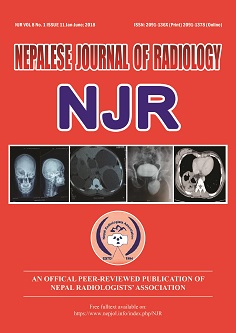Chest Ultrasound- Update 2018
DOI:
https://doi.org/10.3126/njr.v8i1.20465Keywords:
Chest, Sonography, UltrasoundAbstract
The scope of applications of chest ultrasound has been significantly widened in the last few years. Effusions as little as 5 ml can be identified without problems in a standing or sitting position laterodorsal in the angle between the chest wall and the diaphragm.
Portable ultrasound systems are being used to an increasing extent in preclinical sonography, at the site of trauma, in the ambulance of the emergency physician or in helicopters. In the emergency room, at the intensive care unit and in clinical routine, chest ultrasound has proved its worth as a strategic instrument to be used directly after the clinical investigation. Several diagnoses such as pneumothorax, (no sliding sign, no B-lines, no lung pulse, lung point) pneumonia (liver like consolidation with bronchoaerogram) rib fractures (step in cortical bone and hematoma) pulmonary embolism (typical subpleural lesions) can be established immediately. In combination with echocardiography and leg vein compression ultrasound (triple organ ultrasound), the accuracy is more than 90%. The evidence of interstitial syndrome has shown a significant correlation with extravascular lung water in cases of pulmonary edema and noncardiogenic pulmonary edema.
Chest ultrasound helps in the diagnosis and staging of lung cancer. Contrast ultrasound (CEUS) is a new tool for the differentiation of sub pleural lung lesions. Ultrasound guided interventions (biopsy, drainage) are very successful. The rate of complications is low when the procedure is performed by trained therapists.
Ultrasound is a fixed element of several international guidelines.
Downloads
Downloads
Published
How to Cite
Issue
Section
License
This license enables reusers to distribute, remix, adapt, and build upon the material in any medium or format, so long as attribution is given to the creator. The license allows for commercial use.




